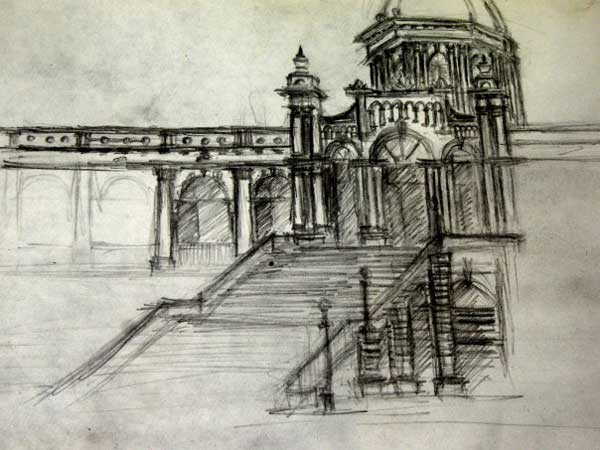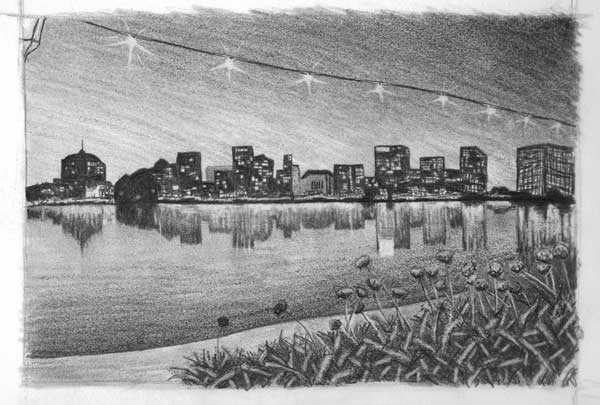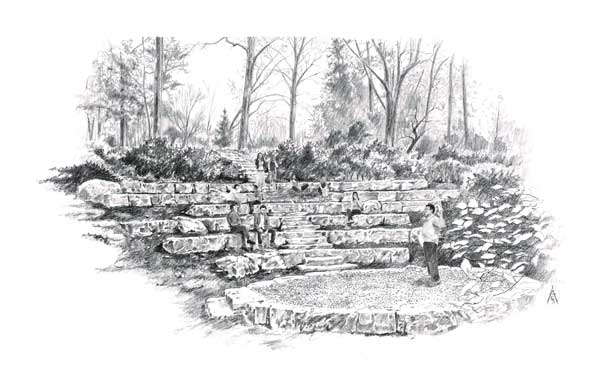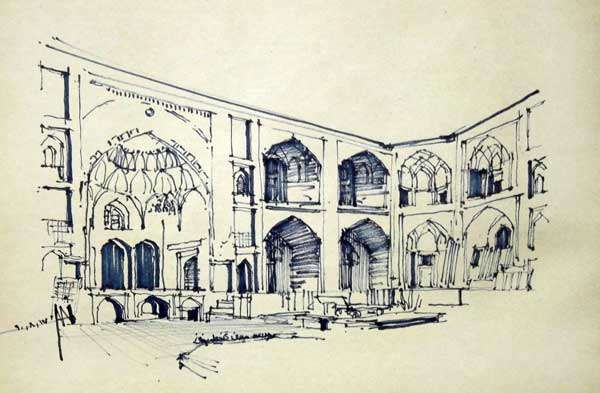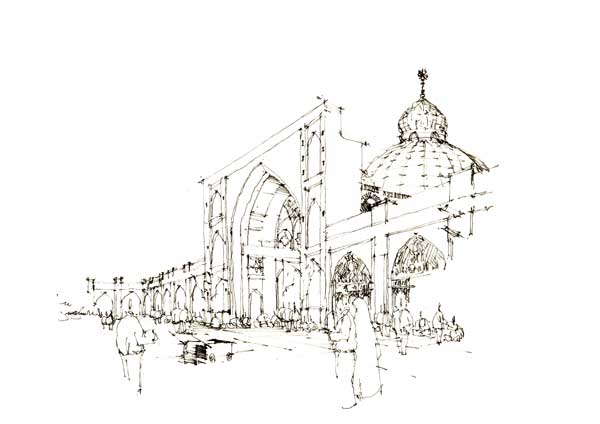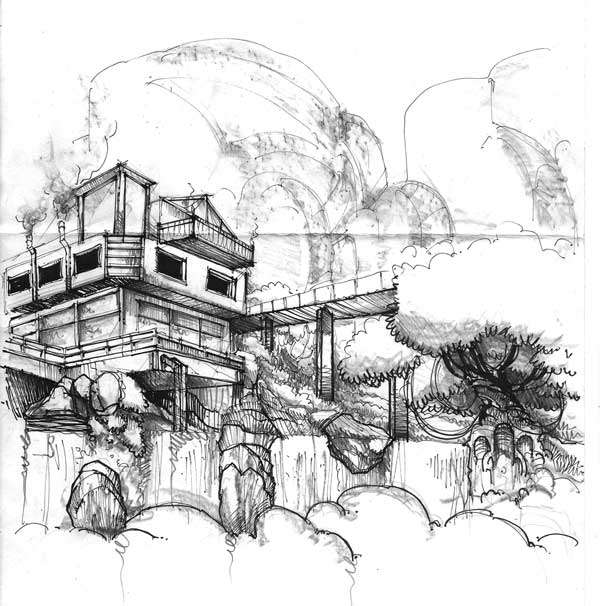Author: Land8: Landscape Architects Network
7 Alternative Ways to Put Your Design Skills into Practice
I’m sitting at my family home over the holiday break reading a book called If I Die in a Combat Zone, by Tim O’Brien. He is remembering his first day as an LZ minuteman somewhere in Vietnam in 1968. The sergeant addressing his new squad says, amongst other things, “Remember your training and you have a good chance of surviving; however, for some of you be certain, your ass is grass.” It reminded me of design school. It was the feeling of looking around the room and wondering out of so many nice and talented people how many would be practicing in the years to come and in what way. There was no secret that the global financial crisis had created a work drought. I thought about training for a professional sport, and after five years not being able to play the game. It scared the hell out of me!
Using your design skills
I’m not sure what training you have done, but in the end, I’m happy about my program, which focused heavily on representation and computer skills. This training has translated to a more professional look when on the hustle and has allowed me to use my landscape architecture skills without the backing of an established LA practice. This article presents seven other ways for those looking to put their skills into practice. 1. Public art The great thing about public art is that it’s a smaller budget, which can be more attainable for a rookie. Insurance in this field can be less expensive, as you are not responsible for all the wider scope of responsibilities that comes with public space. Once in the system, it’s easier to see what’s going on. There’s a reason it takes time to register, and the point is that this can be a way of getting experience in the greater process that unsigned rookies do not get. 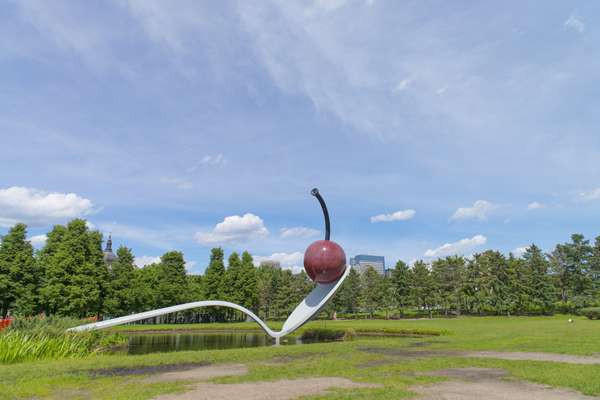 Image credit Plume Photography / Shutterstock Do not try to bullshit your way through art! The fact that you are from the design world may already arouse suspicion and work against you. If you’re going to do it, engage in what it is. Be humble — there are some seriously good artists out there! What artists need to remember is that it’s about public space as well, so as landscape architects we have a very legitimate interest in it.
Image credit Plume Photography / Shutterstock Do not try to bullshit your way through art! The fact that you are from the design world may already arouse suspicion and work against you. If you’re going to do it, engage in what it is. Be humble — there are some seriously good artists out there! What artists need to remember is that it’s about public space as well, so as landscape architects we have a very legitimate interest in it.
Think laterally about where you can use your skills. There is the conflict between what you want to do for work and what you have to do for work. The middle ground is a situation where your skills can be kept up and you can gain an understanding about how things go together. Try targeting the companies that supply the industry. The best element about knowing fabricators is that when you do have a concept, you have a realistic sounding board to make sure the concept is deliverable. Beyond advice is credibility for your practice. The stakeholders are just as interested in your ability to deliver, and there is a lot of money to be lost in construction. Working with specialty fabricators streamlines your process and opens new techniques, which are invaluable if you are working without the backing of an established practice. 3. Studios Get a workspace outside your home. Do this as early in your education as possible. Skimp on the house and get the studio space. I like my studio because there is a small block of designers around — musicians, film people, and painters. It’s nice to walk away from your own snot and bother and be confronted by a different set of triumphs and stresses. There is a greater sense of empathy for all small-scale creative entrepreneurs. It’s really healthy for designers caught outside established practices to engage in other creative disciplines. I bet that if you sat down with many lead designers, they would have a wide range of knowledge beyond landscape architecture. We are in a cultural industry, so it’s beneficial to be around culture. You may also be interesting in reading An Unofficial Guide to Keeping Your Semi Legit Studio Space 4. Get backers The reality is that if you are practicing this way, you are looking for ways to break into the industry with minimal resources and your voice is not as loud as those established in the industry. The best thing you can have is others speaking for you. You may have the best concepts in the world, but until you get things built, they remain concepts. If you can get others to want those concepts, then you become louder. Call it people power. Find a group of people who want something built, then consult, petition, design, and engage and see if you can get it done. Even if you can’t get it done, you’re going to start to learn the process, which may help you stay on the pitch and not wonder where the five years went. 5. Design competitions
Don’t participate in design competitions unless you are invited, paid, or establishing a working relationship with someone. Don’t do them just for the sake of doing them. It’s a lot of energy you could be using to meet people and learn things. Check out the Moved to Care brief from Building Trust International, there is only a couple of weeks left to register. 6. Be credible Make sure you are credible in what you choose if you are looking to practice for yourself. It’s one thing to have the idea, but will anyone really let you do it, and if they do, can you actualize the concept? Don’t force stuff on the rest of the world that is best appreciated by the more academic side of what we do unless you have the appropriate backing. Look at culture as a whole and pick what’s relevant and achievable for you.
You could write for LAN, click on submit and find out more!
Sketchy Saturday l 009
We have got an excellent, fresh set of sketches from our readers for this weeks Sketchy Saturday, to pick our top 10 for this weeks Sketchy Saturday. Be it colour or black and white, technical or artistic, work or pleasure based, we know a good sketch when we see one! Drawing is one of the best ways of improving your work and should never be fully replaced by tech shortcuts! So without further ado, here’s this week’s selection. No. 10 by Tomislav Krnač, Slovenia
‘I drew this sketch in the Mediterranean village of Izola in Slovenia on a beautiful sunny day. We had an excursion with prof. Drašler who taught us drawing in 1st and 2nd year of landscape architecture. I was sitting on a bench in a picturesque little square surrounded by old houses and Mediterranean plants, so I decided to make a quick sketch of it. I used a 6B pencil and a grey promarker.’ No. 9 by Mahmudul Karim Ripon ‘This is a sketch of Ahsan Manzil in Dhaka, Bangladesh. The official residential palace has a beautiful architecture with multiple design details which were, for the most part, drawn here. I focused on the main entrance of the palace and its main detailing. The sketch was done in pencil. ‘ No. 8 by Amaury Martins Neto, agronomic engineer/landscape architect, Piracicaba SP – Brazil ‘I started this project because when working with landscape architecture, you always have to think about sustainability. With that in mind, I designed this two storey house made of four shipping containers and added one more for a studio/guest room. Another idea for this particular design is to show that even with such a small terrain (200 sq. meters) you can have a nice home and a very cool and modern garden designed with native plants.’ No. 7 by Amaury Martins Neto ‘This is a conceptual illustration for a container house. The drawing represents a studio made from a 20ft shipping container. The landscape consists of two water features, a vertical garden, wood deck and pool, designed only with native plants.’ No. 6 by Irene Morales, 3rd year landscape architect student at the University of the Philippines, Dilima ‘This is an output from reading a book on how to do pen sketches.’ No. 5 by Philip Tsui ‘I made this sketch of a Chinese traditional garden in Guangdong Province,China. Stone is an important and special element of the Chinese traditional garden, so I set the stones as the main part of this sketch. There is a wooden pavilion on the stone hill. I used pen and marker pen to colour it..’ This layered sketch attempts to have a strong impact on the viewer bringing you into the depths of the picture showing the raw lines of the original sketch while being brought to life with vivid and bold color, making for one dramatic composition. What we love about this sketch is the honesty and purity of form, communicating a place with a lot of character, which is bound to be a reflection on the designer. No. 4 by Miguel Lievano ‘This very quick sketch was done from the Castel Sant’Angelo overlooking St Peter’s basilica in 2000. The idea of the sketch was more to capture the ‘essence’ of the view rather than to dwell on the details.’ No. 3 by Rebecca Blanck-Weiss ‘This scene of Oakland, California’s Lake Merritt Promenade at night was sketched using a 2b pencil and a fine tipped eraser. There is a string of lights wrapping around the lake along the path that beautifully reflects the lights of the city, which also surrounds the water. This community space, bustling with people walking, biking and running all day is very still at night.’ No. 2 by Devin Kimmel ‘This is a sketch of a new woodland amphitheatre for a private school. Its purpose is for outdoor teaching and events. The amphitheatre is set in a beautiful natural ravine overlooking a creek. This sketch was done using graphite on vellum.’ No. 1 by Alexander Kok, professional visualizer, Noordwijk, Netherlands ‘This is a plan made to redevelop an old office building in the heart of the city of Amersfoort, Netherlands. The project is named Business Garden and the sketch’s purpose was to create an idea of a garden and work space in the atrium with the other units individually rented by small companies. The whole idea had been based on the concept of zero carbon/low ecological footprint developed by the Dutch based One-Planet foundation. The project was initiated by British/Norwegian engineer Paul Heistein, who is a specialist in the use of alternative energy sources and connecting the various participants involved. One Planet Foundation will have their headquarters in this building..’ Thus, Sketchy Saturday, version 009 is concluded! It was a tough choice, as per usual, because each sketch has something special. If you enjoyed this week’s selection, check out our previous edition. Don’t forget to send your work along with a short description of the sketch to get a better chance of having your work selected for our weekly Sketchy! See you next Saturday! Article written by Oana Anghelache.10 Qualities You Need to be a Great Designer
After the success of his last article “10 Ways Design Students Fail Projects and How to Avoid Them” designer and lecturer Barry Lupton joins us again at Landscape Architects Network to give us his thoughts as to what qualities a great designer possesses:
Designers are complex beings occupying an increasingly complex domain. The skills, traits and characteristics which define the greatest designers are equally complex. To provide some insight, I’ve undertaken some reflective analysis of my own skills, traits and characteristics. I then used a useful antonym website to compile the list below.
1. Sorry, come again?

Good communication skills are vital to the design process; image credit: Monkey Business Image/shutterstock
Verbal communication is both a science and an art, and great designers can usually orate and articulate with the best of them. Designers must be adept at reading an audience and adjusting to suit, being succinct, engaging, passionate without being frightening, and most of all, they must be clear.
But don’t worry, if you eh, um, ah, uh, like…the ability to communicate can be learned. If you want to write well, read; if you want to communicate well, listen and speak to the right people.
2. Thick skin
Let’s face it, if you’re not prepared to have your wonderful ideas sneered at, torn to shreds, violated, stolen, compromised and generally beaten into submission, you should really think about becoming a tortured artist. All good designers need to have a very thick skin. They will usually have a callused tongue from biting it in meetings.
On the positive side, the terrible things done to ideas are these days typically referred to as collaboration; and everyone loves collaboration, right?
3. Knowing when to bang your fist
Real change is only brought about by the conviction, stubbornness and perseverance of groups and individuals. More often than not, it’s the work of the latter. Although designers must have a thick skin, great designers also have unwavering commitment, passion and belief in what they are doing. Great designers also recognise when it’s right to bite their tongue or bang their fist.
Don’t believe in what you’re doing? Then stop doing it.
4. Job juggling
The best designers can transfer their skills to any task and juggle a multitude of activities at any one time. In fact, one of the benefits of quality design training is the knowledge and ability to take anything on.
A great designer will never be out of work.
5. In weakness there is strength
The designer skillset touches domains from psychology to soil amelioration, and it’s impossible to be an expert in everything. The best designers know, and are comfortable with their strengths and weaknesses. They embrace both and are not afraid to draw in advice and support from those more able.
If you lack brilliance, seek it in others.
6. Mind your see-saw
The great designer’s mind is akin to a seesaw. On one side sits an artist, on the other, an engineer. The designer sits in the middle, balancing the demands of what the artist saw and what the engineer sees. Great designers and great designs, reconcile these perceived opponents, and do so effortlessly.
If you find yourself saying things like…”I hate all that emotive, conceptual stuff” or, “I’m not one for detail drawings”, you are probably veering too far on one side of the design see-saw.
7. The knowledge between a rock and a soft place There is no escaping it, great landscape architects know and love plants. They also know hard materials inside and out, and understand the complex interface that exists between the two. It could be posited that a designer’s life centres around building knowledge of hard and soft stuff; and figuring new ways to mediate their relationship to satisfy client demands.
Want to be a great designer? Embrace your mediums of expression.

The Highline is a great example of merging both soft and hard materials to create a masterpiece; image credit Sean Pavone/shutterstock
8. Problem finders
You’ll often hear people saying that good designers are good problem solvers; this is certainly correct, but great designers are also brilliant problem finders. And I’m not referring to critics, they’re a different breed. Problem finders are those that recognise potential and opportunity where others see obstacles and reasons for not doing something. If you’re a great designer, you already do this every day, probably all day; in fact, you might well be consumed by it. Don’t worry, you’re not alone.

Having mulitple personalities can aid the design process; image credit: Straight 8 Photography/shutterstock
9. Split Personality
There is no one specific personality trait which lends itself to design brilliance. Certain traits, like extroversion and openness, can aid imagination and support team working abilities. Conscientiousness on the other hand, can feed a designer’s capacity to experience empathy; an important factor in all aspects of design. It also lends itself to managing one’s own time.
While there is no one personality trait, many designers are naturally reflective. Others, often as a response to the fuzziness of design training, learn to develop reflective skills. They learn one of the most important design skills required for brilliance: to question oneself.
10. Beware of wariness
The most important characteristic of a great designer is awareness. Some designers are simply born aware. Others, through training and experience, have their senses heightened and they become alert. The world becomes alive, exciting, stimulating and even the most banal becomes a source of inspiration to be explored, saved, and reinterpreted. Awareness drives the design mind.
If this doesn’t resonate with your core, you aren’t doing it right.
Don’t worry if none of the above resonates with you. You can always do what the vast majority of designers do until they’re recognised for their brilliance: work damn hard, grab opportunities as they arise, and always be willing to blag, charm and hoodwink your way to the top. You can always say you had these traits at a later point.
Article written by guest writer Barry Lupton MGLDA
Barry Lupton has spent the last 15 years dividing his time between creating gardens and landscapes, lecturing in design and environmental studies at Senior College Dun Laoghaire, and writing on industry matters. He can be contacted through his website: www.barrylupton.com Featured image: Monkey Business Image/shutterstock
Planting Green Roofs and Living Walls by Nigel Dunnett and Noël Kingsbury | Book Review
In today’s day and age, with our natural environment ever diminishing, every potential green space in the concrete jungle of our cities becomes increasingly important. Green roofs and living walls are one of the most important ways of making our cities greener – and they are also incredibly fashionable! It is vitally important for every landscape architect to realize the value of green roofs and living walls and gather as much information as possible about their uses, benefits, and construction. This book is a great place to start!
Planting Green Roofs and Living Walls
What you get from this book
- An excellent introduction to the idea of green roofs and façade greening
- A perfect guide to the construction practices
- An explanation of the genesis of the green roofs and walls movement
- Ample information on implementation
Book review by Marta Ratajszczak
10 Easy Ways for Landscape Architecture Students to Network with Professionals
Every student thinks: “What will I do after school?” For most students, getting a job in the field of design is the highest priority. The 2013 ASLA Recent Graduate Survey indicated that 89 percent of graduates will seek employment and hope to enter the field immediately after college. We have 10 tips to help you get a head start allowing you to network with professionals while increasing your odds of landing a job right out of school. 10. Stop by their offices and introduce yourself The internet has come to dominate our communications world. Remember that nothing goes further than a handshake and a smile. While many offices have the ability to work from remote locations and can hire from afar, small businesses are still the majority. 9. Join your professional society Professional societies such as ECLAS, ASLA, AILA, and CHSLA are the hub for your student and professional needs. Having a professional membership comes with many benefits. Societies often release publications highlighting professionals, create educational sessions with professionals such as webinars, and have job postings listed. 8. Attend local professional meetings

Visitors walk past stands at the Ideal Home Show 2013 in London on March 15, 2013; Image credit: pcruciatti / Shutterstock.com
Meetings are the best place to get to know numerous professionals at once. Professionals typically need to acquire continuing education points throughout the year. Take advantage of these meetings and dive right into the mix. Numerous firms are often represented at each meeting. If you don’t have a local professional group that meets in your area, get together with those in your field and start one. This shows initiative and impresses any employer.
7. Leverage social media platforms One of the easiest ways for professionals to check out a potential hire (you!) is to search for your name. Don’t make the mistake of letting your online presence prevent you from getting a job. In fact, consider social media an asset. While content can never replace quality, more exposure places you in front of a larger number of professionals. It is debatable which media outlet accomplishes more. Here is a quick list: personal website, Facebook, LinkedIn, Google +, Tumblr, Pinterest, Houzz, Land8, Twitter. The key here is to know the audience you are marketing to and make those connections. Feel free to visit my site and these others for examples
- Website: Cameron Rodman
- Facebook: Olin Studio
- LinkedIn: Ken McCown
- Houzz: Stephen Hackney
Universities, local governments, and other businesses such as newspapers host career fairs. Enhance your portfolio and resume and get cleaned up. Firms expect students to show up with their best, looking their best. 5. Studio interaction at school Many colleges invite professionals to lead or participate in academic studios. Drink in their experience and wisdom. Ask them questions about why they think the way they do and challenge yourself to think the same way, at least for a semester. 4. Volunteer for community service Think about the organizations in your community that might have relationships with landscape architects, and get involved. Many communities have community design centers that gather professional services for those who cannot afford them. 3. Don’t forget those professionals close to your field Landscape architects do not operate in a bubble. Connect with local architects, engineers, planners, horticulturists, government officials, and community activists. These are the people we interact with and learn from on a daily basis. 2. Find media outlets about landscape architects Numerous publications and online resources exist that can help us connect to other landscape architects. Read our recent article Top 10 Online Resources for Landscape Architecture to find out more. 1. Become the professional Some areas across the globe may not have many landscape architects. Take the initiative to learn what you can, and connect with those around you. Set up a strong foundation for those who will follow in your footsteps. Whatever your reason is for networking, the most important thing to do is to have an understanding of where you want to go and who can help you get there. Good luck, and keep checking back with Landscape Architects Network for up-to-date news on everything related to landscape architecture. Article written by Cameron R. Rodman Featured image: Hasloo Group Production Studio/shutterstock
Sketchy Saturday l No. 008
Our 8th edition of Sketchy Saturday, the first in the New Year! With all the quality work we’ve been receiving, we could easily churn out several of these each week! It is always a difficult task to select the best from the best. Well, let’s check out this week’s top 10 sketches. Prepare to be inspired and possibly spontaneously get your drawing gear out and submit some more for our selection! 10. by Manizheh Eskandari, Iran
‘I did this sketch in a cold evening with my husband (sitting nearby) in a boys’ school in Kerman. This school is only for boys who want to study something about Tradition and Religion, in Kerman’s Ganj Ali Khan square. Fortunately this school was open for the public because of reparations at that time. Ganj Ali Khan School such as most of Iranian schools has a rectangular yard with two perpendicular and 4 porches (ivan), Islamic arches, geometric tracery and ceramic mosaic tiles. I was sitting at the corner and drawing this picture for about 30 minutes, 2 years ago.’ 9. by Azmi Bin Elias, Malaysia ‘This sketch is an imagination exercise on how people live in their traditional Malaysian village. This sketch also shows the Malay culture and traditional activities. It shows how the Malay people interact with each other in order to show tourists traditional activities in Malaysia. Such as marriage traditions, traditional foods, the things they do all follow the Malay tradition. The sketch will hopefully give you a perspective on Malay culture and tradition, so do come visit Malaysia.’ 8. by Yi dae-young, principal at ‘Landscape design studio L’, Seoul, South Korea ‘This is a sketch of an existing private garden in Han-nam dong in Seoul, Korea. This garden design successfully shows the traditional space character ‘ma-dang’ and harmony with others. It was drawn in colour pencil rapidly on moleskin notepaper, which took about 15 minutes.’ 7. by Nayeli Pérez Contreras, architecture student from Puebla, México ‘The sketch is a perspective with two vanishing points of a house in a minimalist style. I added details with wood and brickworks and also a stone wall. I think that these elements create a natural landscape. I used the watercolour technique.’ 6. by Dipti Kharel, Nepal ‘I did this sketch in my 1st year of undergrad. This building is an example of neo-classical architecture (one of my favourites) which happened to be an assignment in our freehand sketching class..’ 5. by Meyssam Seddigh, Iran What we love about this sketch is its scratchy style, while it misses out on details it encapsulates the emotions and history of the space, the beauty of a sketch is that it doesn’t just capture the subject but also the moment in which it was drawn. ‘This is a sketch of Tehran’s Imam Mosque in the old Bazaar. This place has been built to gather people together to solve their religious and social problems. This place is used for prayers at noon. The yard site is part of the bazaar. It has an atmosphere of nostalgia for every Iranian. I’m sitting on the ground, in front of this view, while I draw this sketch. I’ve used ink pen for this sketch which was completed in about 1 hour.’ 4. by Ronak Roshan Gilavaie, Rasht, Iran ‘This is a freehand sketch of a cityscape in Rasht done in December 2013 using black drawing pencil on normal paper at A4’ 3. by Patrick Francis Nelligan, student at The Pennsylvania State University ‘This sketch was constructed on task board with ink, coloured pencils and a parallel glider. The objective was to recreate Frank Lloyd Wright’s 1936 perspective drawing of the Edgar J. Kaufmann House (via The Frank Lloyd Wright Foundation) while concentrating and clarifying the surrounding forest canopy structure. Placement of a Cherokee Red blanket over the main balcony provides an intense focal point within the hushed woodland of colour. ” 2. by Hannah Wilson, landscape architecture student at Iowa State University ‘This is from travelling from Minnesota to Mississippi with Iowa State University’s Savannah Studio. This is a 20 minute sketch done at Eagle Point Park, in Clinton Iowa. It’s mainly observing the Alfred Caldwell structures and design, done in coloured pencil.’ 1. The House by Mohamad Azam, Malaysia ‘It was based on the Fallingwater residence by architect Frank Lloyd Wright. I created this in late 2012 after finishing my diploma in Landscape Architecture.’ So there we have it, another selection of inspiring sketches of landscapes and fine architecture. It’s always a pleasure to look through fresh, brilliant work by our readers. Tune in next week for a new set of Sketchy Saturday and check out the previous edition as well. And remember to send your work along with a short description of the sketch to get a better chance of having your work selected for our weekly Sketchy! See you next Saturday! Article written by Oana Anghelache.Lombok International Bamboo Architecture Festival 2013
Bamboo, one of the fastest-growing plants in the world, has gained its cultural and economic significance in Southeast Asia not only due to its speedy growth, but also thanks to its marvelous strength, which allows it to be often used as building material instead of steel. This peculiar monocot plant is also a popular ingredient in Asian cuisine and can be used to create fine, long-lasting furniture and other diverse structures. And bamboo was also the centerpiece of an international festival initiated this year in Lombok, Indonesia, in the hope of making it an annual event.  Image credit: www.budipradono.com
Image credit: www.budipradono.com
Lombok Bambu Festival
Through the slogan We Care Bamboo, the Indonesian Institute of Architects-West Nusatenggara Region introduced LIBAF — the Lombok International Bamboo Architecture Festival — with the aim of highlighting the significance of bamboo, which according to the architects is “almost forgotten in its potential as a local Indonesian material in architectural and structural works”. The event was held Dec. 1-8, 2013, in cooperation with organizations such as Budi Pradono Architects and the Ministry of Tourism and Creative Economy in Lombok Island, Indonesia. The festival at Senggigi Beach Lombok was attended by more than 300 participants, including architects, architecture students, and artists from all around the world. It included workshops and seminars on the planting of bamboo and on themes such as Re-Designing the World with Bamboo, as well as a Bamboo Architecture Artwork Installation.  Image credit: www.budipradono.com
Image credit: www.budipradono.com  Image credit: www.budipradono.com
Image credit: www.budipradono.com
The latter is an exhibition of about 20 architectural displays with bamboo as the primary material used. The displayed structures were selected prior to the event from hundreds of designs that were submitted. The installations will remain on exhibit until March 2014, then will be donated to a bamboo park that will be intended to become a main attraction in the area.
 Image credit: www.budipradono.com The Art Installations Each architectural bamboo work was designed by a different person from a distinct country, each with a unique message. Below are links to some of the most impressive features on display at the bamboo architecture festival: Kendi Maling, designed by Indonesian Wiralee Adiputra, is a sculpture that imitates the shape of a traditional jar from Lombok that holds the same name. Through this design, the artist aimed to introduce the traditional Lombok culture to an international audience. Bamboo Shadow Box, by French architect Marine Lacroix, was designed to let the people of Lombok use it as their own shadow theater and perform arts and express themselves.
Image credit: www.budipradono.com The Art Installations Each architectural bamboo work was designed by a different person from a distinct country, each with a unique message. Below are links to some of the most impressive features on display at the bamboo architecture festival: Kendi Maling, designed by Indonesian Wiralee Adiputra, is a sculpture that imitates the shape of a traditional jar from Lombok that holds the same name. Through this design, the artist aimed to introduce the traditional Lombok culture to an international audience. Bamboo Shadow Box, by French architect Marine Lacroix, was designed to let the people of Lombok use it as their own shadow theater and perform arts and express themselves.
 Image credit: www.budipradono.com
Image credit: www.budipradono.com
 Image credit: www.budipradono.com For further information see also: www.budipradono.com www.lombokbambufestival.com Article written by Dalia Zein
Image credit: www.budipradono.com For further information see also: www.budipradono.com www.lombokbambufestival.com Article written by Dalia Zein
The Lazy Photographer’s Guide to Photoshop
Have you ever taken a photograph and uploaded it only to find out later that someone has photo bombed your family photo or the exposure wasn’t right on that killer landscape shot? You are in good company.
Whether you are a seasoned professional or a selfie guru, it is inevitable that some of your photos will be botched. Don’t worry. Landscape Architects Network has a few Photoshop tips that can help you redeem your lazy photography habits.
Landscape Architects Network reached out to European travel photographer and editor at HDR One Magazine Jimmy McIntyre and American nature and design photographer J. Paul Moore or their tips for the Lazy Photographers Guide to Photoshop. Here’s what we all came up with.
Use Adjustment Layers to Make BIG changes
The first set of tools that you need in your Photoshop arsenal is the adjustment layers. Gradients, brightness/contrast, hue/saturation, and gradient maps are a few of the many adjustments which you can leverage to enhance the mood and feel of a photo. These tools can be accessed by opening your adjustments panel on your right tool bar or by clicking on the circle that is half way filled with black and white at the bottom of your layers panel.
Let’s dive into Brightness and Contrast. Once you click on the appropriate icon or layer adjustment you will see two slider bars. Click, hold, and drag these to the left and right to alter the image. A simple way of understanding brightness is thinking of it as a tool to lighten or darken the overall image. Contrast increases the difference between the light and dark pixels. This achieves a look of high intensity and greater color saturation.

Image credit : Jimmy McIntyre, Using saturation to make dramatic changes and improvements to your photos
The next adjustment layer to arm yourself with is Saturation. Jimmy McIntyre had this to say:
“Firstly, when you want to quickly saturate or desaturate a particular colour, open up a saturation adjustment layer, click on the hand with two arrows either side of it (next to the word ‘Master’), and then move your cursor to your image, select the specific colour and while holding the left mouse button down, move the cursor left or right to desaturate or saturate that colour.”
This is one of many fantastic ways to make black and white images or enrich a photograph’s color.
Making Good Use of the Tool Box Panel
The second set of tools that you need to become familiar with is the Tool Box Panel. This panel includes healing brushes, the clone stamp tool, the history brush, and more. One tool that many landscape architects are familiar with is the Clone Stamp tool. This tool looks like a rubber stamp and is often located on the left side of your screen. Use the clone stamp tool to remove or add desirable and undesirable parts of a photo. Check out this before and after shot where a person stepped into the view.
Here’s how you do it.
Step 1: Create a new blank layer by clicking “new layer” at the bottom of your layers panel.
Step 2: Click on the clone stamp tool. At the top of your computer window find the word “sample.” Click into this drop down menu and select “all layers.”
Step 3: Next, place your mouse over the portion that you would like to clone. While holding down the Alt (PC) or Option (Mac) key, left click on that area and release the Alt or Option key and the mouse clicker.
Then…
To stamp that area, place your mouse pointer over the area you want to alter and left click, hold, and move your mouse around. This stamps the desired area here.
One Final Tip
Our final tip comes from J. Paul Moore. He shared with Landscape Architects Network the usefulness of the Content-Aware Move tool. He used this tool to “eliminate water spots by the pool, remove bright reflections from the edge of the pool caused by the umbrella pole, and to fill in a few small spots on the left side of the far left arborvitae.” This is a useful tool to help control the viewers’ attention.
To use this tool, click into the spot healing brush drop down on the left tool bar. Once you have selected the Content-Aware Move Tool find a spot on your image which you would like to reference. Trace the spot with your mouse cursor. Then click this selected area and drag it over the area you wish to alter.
We hope that these tips for the Lazy Photographer have been helpful. Photoshop is a powerful tool for photographers and landscape architects. Have fun!
J. Paul Moore Official Site
Through Strange Lens
Related Articles:
Article written by Cameron Rodman
Top 10 Sacred Trees
The significance of trees to Mother Earth and to us humans is immeasurable. Since the dawn of time, these majestic living organisms have been a strong feature in folktales, history, paintings, and other forms of culture and art. Their awe-inspiring shapes and strength — sometimes daunting — can invoke a powerful sense of spirituality. For centuries, civilizations have praised trees as a symbol of worship, celebration, and death; some rituals persist today. Based on aesthetic or religious significance, the following list of 10 sacred trees is meant to acclaim the spiritual relationship between humans and trees.
10. Willow Tree
 Image credit: Tshooter/shutterstock
Image credit: Tshooter/shutterstock
Willow trees from the genus Salix come in all sorts of varieties and shapes. Most species of this tree thrive in riparian landscapes. A willow’s presence near water can be haunting. In Japanese tradition, it is believed that wherever a willow is present, a ghost will appear. Due to the association with the movement of the water to the moon, willows are also considered sacred in witchcraft. Priestesses of the Goddess Hecate of the Moon use willow water in their magic.
9. Ash
 Image credit Smileus/shutterstock
Image credit Smileus/shutterstock
There are records of several trees of mythical importance to the Celts, including oak, apple, birch, and ash. The latter has a connection to the order of the bards, ovates, and druids (Celtic priests). The ash tree (scientific name: Fraxinus) is mainly associated with healing and enchantment, and in particular to the Welsh magician/god Gwyddion, who had an ash wand. The tree is also similarly associated in Norse mythology to the god Odin.
8. Sacred Oak
 Image credit: Dudarev Mikhail/shutterstock
Image credit: Dudarev Mikhail/shutterstock
Believed to be the largest yellow oak (scientific name: Quercus muhlenbergii) in the United States, this iconic tree located in Oley, Pa., dates back almost 500 years. The tree received its “sacred” attribution due to a native Indian legend that claims that the tree possesses the power to heal. This sacred tree was looked upon as the shrine tree of the Delaware Indians, who prayed for it whenever they needed help.
7. Italian Cypress
 Image credit: Zoom Team/shutterstock
Image credit: Zoom Team/shutterstock
Known as “The Mournful Tree”, the Italian cypress (scientific name: Cupressus sempervirens) has been associated with death and mourning for the past 2,000 years. Planted in Islamic and European cemeteries, the tree’s legend goes back to ancient Greek and Roman mythology, when a man named Cyparissus accidentally killed his stag and begged the gods to punish him with eternal grief. Granting his wish, the gods turned him into a cypress tree, which would forever stand and mourn the dead.
6. The Bodhi Tree
 Image credit: nuttakit/shutterstock
Image credit: nuttakit/shutterstock
The sacred fig (scientific name: Ficus religiosa) is native to Nepal, India, Pakistan, and Bangladesh. It is known as the Bodhi Tree (Sanskrit for “wisdom” or “enlightened”). It is believed that it is under this tree that Buddha gained his enlightenment. After Buddha’s death, the tree became a symbol of his presence and an object of worship. At Bodh Gaya, a new Bodhi was planted in 1881 after the original one died. Many other Buddhist temples plant this tree, as well.
5. Witch Tree
 Image credit: nikitsin.smugmug.com/shutterstock
Image credit: nikitsin.smugmug.com/shutterstock
The Little Cedar Spirit Tree, or the Witch Tree, is an ancient iconic specimen from the specie Thuja Occidentalis. This tree grows on the shore of a lake in Minnesota and is sacred among the Chippewa Indian tribe. Earliest records of this lone tree date back to 1731. From the fear of it being vandalized, the tribe has purchased the land and people are now prohibited to come near the tree. 4. Banyan Tree
Another tree that is sacred in Buddhism as well as in Hinduism is the banyan tree (scientific name: Ficus benghalensis). Native to Southeast Asia, the tree’s uniqueness lies in its aerial roots, which spread upward. eventually becoming accessory trunks. Due to this shape, the tree represents eternal life. In a song called the “Bhagavad Gita” or “Song of the Lord”, Krishna uses the banyan tree as a symbol to describe the true meaning of life to the warrior hero Arjuna. Banyan is also mentioned in the Buddhist Jataka tales.
 Image credit: Javarman/shutterstock
Image credit: Javarman/shutterstock
3. Lebanese Cedar  Image credit: Diak/shutterstock
Image credit: Diak/shutterstock
Ever since the Phoenician times, this tree has attained an economic significance due to the preciousness and power of its wood, as well as a symbolic one due to its ability to age for thousands of years and withstand a snowy, mountainous climate. The Lebanese cedar (scientific name: Cedrus libani) does not only hold a religious Christian significance — it is mentioned in the bible 75 times — but is also a symbol of national pride, as it is the national emblem of Lebanon.
2. Baobab Tree
 Image credit: Nazzu/shutterstock Native to India and the African Savannas, the baobab (scientific name: Adansonia digitata) is a national emblem of Madagascar. Due to its massive size, fascinating shape, and long aging (around 3,000 years), people believe the baobab holds the spirits of the dead, and that is why it is sacred in African culture. Throughout history, kings have organized their meetings under this tree, believing that it holds magical properties that could aid them in making wise decisions.
Image credit: Nazzu/shutterstock Native to India and the African Savannas, the baobab (scientific name: Adansonia digitata) is a national emblem of Madagascar. Due to its massive size, fascinating shape, and long aging (around 3,000 years), people believe the baobab holds the spirits of the dead, and that is why it is sacred in African culture. Throughout history, kings have organized their meetings under this tree, believing that it holds magical properties that could aid them in making wise decisions.
1. Christmas Tree
 Image credit: Volodymyr Goinyk/shutterstock The most renowned sacred tree of our time is the Christmas tree. Around December, almost every Christian home and many non-Christian houses have one adorned with all sorts of lights, ornaments, and gifts. Various species of conifers can be used as a Christmas tree, such as Abis alba pyramidalis. Prior to attaining its Christian religious significance, it was known as the Yule tree (Yule is the day celebrating the coming of the winter solstice) in pagan tradition and was decorated as an outdoor live tree with hanging candles. The latter tradition still persists today in neo-pagan religions such as Wicca. Trees have always provided food, shelter, wood, shade, and many other basic life needs for human beings. It is no wonder, then, that they are worshiped or praised in every civilization. In many cultures, it is believed that hugging a tree releases negative energy from the human body. So do not forget to hug trees from time to time, and happy holidays! Article written by Dalia Zein Featured image: Image credit: Javarman/shutterstock
Image credit: Volodymyr Goinyk/shutterstock The most renowned sacred tree of our time is the Christmas tree. Around December, almost every Christian home and many non-Christian houses have one adorned with all sorts of lights, ornaments, and gifts. Various species of conifers can be used as a Christmas tree, such as Abis alba pyramidalis. Prior to attaining its Christian religious significance, it was known as the Yule tree (Yule is the day celebrating the coming of the winter solstice) in pagan tradition and was decorated as an outdoor live tree with hanging candles. The latter tradition still persists today in neo-pagan religions such as Wicca. Trees have always provided food, shelter, wood, shade, and many other basic life needs for human beings. It is no wonder, then, that they are worshiped or praised in every civilization. In many cultures, it is believed that hugging a tree releases negative energy from the human body. So do not forget to hug trees from time to time, and happy holidays! Article written by Dalia Zein Featured image: Image credit: Javarman/shutterstock
Landscaping With Australian Plants l Book Review
As a landscape architect, possessing at least a modest repertoire of plant knowledge is a fundamental skill. More often than not the horticultural aspect of your time at university is rather brief – so if you’re not already versed in verdure, you need to take matters into your own hands! An absolute mastery of horticulture isn’t compulsory, but it’s important to remember that plants are one of our principle forms of expression within the landscape, and our countries native species link us to our land and give us a sense of place. Making this book on Australian plants all the more important.
What is this book about?
From arid deserts to coastal dunes, many of Australia’s tens of thousands of different indigenous plants have for the past two centuries been cultivated and experimented with for both functional and aesthetic purposes. This book delves into the vast assemblage of Australian flora and provides practical ideas and advice on how to grow hundreds of the nations native species in a contemporary landscape setting.
What’s inside?
John Mason is a seasoned horticulturist, author, and general garden guru. He first familiarises the reader with the history of Australian gardens during the early years of settlement, and how influences from prominent designers throughout the 19th and 20th century procured the nations own unique style of gardening. Following this archival narrative, Mason introduces the different characteristics of gardens in Australia and the ways in which many natives, although traditionally found in natural bush settings, are now being incorporated into various garden styles – all that’s needed is some careful pruning, positioning, and training.
The subsequent three chapters take the reader through the functional uses of natives, such as acting as windbreaks, firebreaks, or supporting wildlife; how to grow natives effectively, and the plethora of factors determining the plants success; and the components of a landscape and all the elements which may be manipulated when designing. Ensuing this, chapters six through to eleven are designated to the exploration and explanation of the most popular indigenous trees, shrubs, flowers, ground covers and climbers, conifers and palms, and ferns. The book contains ample photographs, many of which are Masons’ own. These act an effective visual narrative for horticultural newcomers, with the reader being able correlate text and image with ease. Text is clear and uncomplicated, with a simple hierarchy of colour and size depicting relative importance.Why should I get Landscaping With Australian Plants ?
As an Australian and a landscape architecture student, for me this book is obviously a win. But why should you get it? What if you don’t live in Australia? Well you might be surprised, but many Australian indigenous species are actually becoming favored around the globe; from the UK to North Africa and Japan to Singapore. The large spectrum of climates and bioregions within the continent has given rise to a range of diversified planting options that may well prosper in your own country! Plants really are a landscape architects stock in trade, so start expanding your inventory. However, don’t feel disparaged if you’re not studying or practicing landscape architecture – as this book befits even the most elementary gardening enthusiast. Click here to pick up your copy of Landscaping With Australian Plants About the author (taken from ACS Distance Education) Mr Mason has over 40 years experience in the fields of Horticulture, Recreation, Education & Journalism. He has held positions ranging from Director of Parks & Recreation (City of Essendon) to magazine editor. John has lectured in Technical & Further Education Colleges (TAFE), and is a well respected member of many professional bodies. He is the author of more than forty books, and of hundreds of magazines and newspaper articles. He is a keen photographer, with many of his photographs having been published in books and magazines. Publisher: ACS Distance Education Type: eBook Page Length: 192 pages Book review written by Paul McAtomney.
HDR and Digital Blending Courses
Are you ready to take your post-processing skills to incredible new heights and create images that make your audience say ‘wow’? Photography is a big deal in the profession of landscape architecture, not only is it vital for site analysis but it helps sell projects to prospective new clients, showing them just how professional you can be with your photography and showing your work in the most impressive way imaginable. Maximizing your photography skills will always be of benefit to both the emerging and professional landscape architect. Top photographer Jimmy Mcintyre from Through Strange Lenses has teamed up with Landscape Architects Network to offer online courses at a discounted rate for all LAN readers of 15% with the code: landarchs Offer expires in 72 Hours
What people are saying about the course:
Quote from Blake Rudis: “Jimmy’s Advanced course will take your cookie dough post processing and carve it into wood with utmost craftsmanship” Quote from Chris Newham: “I am taking this course the videos are clear and demonstrate everything, all the files are provided for you to follow along and you can compare your result with Jimmy’s. I’m very pleased, I think you will be too.”
What the HDR and Digital Blending courses include:
The Art of HDR beginners course: This is possibly the most comprehensive set of beginner to advanced post-processing tutorials in the world. Thousands of photographers and visual artists have transformed their imagery using these techiques! Comprised of 3 separate courses, the beginners course -The Art of HDR – will show you how to make compelling and realistic HDR images through studying 10 full workflows! The Art of Digital Blending: This course takes you beyond HDR into digital blending in Photoshop, the most powerful method for creating images that contain the fullest dynamic range of light possible. Teaching a 100% non-destructive workflow, this course will sharpen your skills in Photoshop and bring your imagery to a professional standard. The Art of Cityscape Photography: This course takes your Photoshop skills to newer levels, and teaches two new digital blending techniques that will transform your urban and cityscape photography forever! Click here to get your chosen HDR and Digital Blending courses. For your 15% discount use the code: landarchs Offer expires in 72 Hours
10 Ways Design Students Fail Projects and How to Avoid Them
We’ve all experienced it at some point — that sinking feeling when you know a landscape project isn’t going to pass. Toe-curling anger, frustration, regret, shame, embarrassment … and that’s just the tutors. There are many reasons why landscape architecture student projects fail to achieve a passing grade, and over the last decade, I’ve seen and heard just about all of them. Often, students focus on the poor grade as the primary negative. It’s not. The true downsides of project failure include the impact on self-esteem, confidence, and motivation and the impact on proceeding projects. To help you make sure projects get through the grading process unscathed, I’ve put together a list of key things to keep in mind. The list is not exhaustive, but it should help. 10. I love your Caesar salad, but I actually ordered steak
Although the design brief represents the hub of any landscape project, it is often overlooked, ignored, or avoided out of fear or forgotten in the excitement of design ideation. “Eh … we’re supposed to have sections and a model; I didn’t see that in the brief?” To avoid serving Caesar salads when steaks were ordered, do the following: Read the brief a number of times, highlight keys points, have a discussion with colleagues, form a consensus, ask questions, pin it to your board and make a point of revisiting it numerous times over the project duration. No matter how wonderful your ideas, always deliver what was asked in the brief. 9. Did you read the small print? Learning outcomes are statements used by tutors to inform the grading process. They are often ignored by students, as they may appear complex. Many students simply skip over them in the rush to see what they have to “produce”. Outcomes should clearly indicate what is expected; they sit beside the wider design brief in terms of importance. Read them carefully. Ignore them at your peril. 8. ‘Cause I just like circles, that’s why The most important word in a landscape architecture student’s vocabulary should be WHY? The search for WHY is a foundation stone of design education; it underpins all conscious design decision-making and, for those with passion, it fosters a lifelong inquisitiveness. Design is a purposeful and intentional process, and good projects are always well justified and rationalized. WHY should be a known. If you want to fail a project, start your presentation with eh, well eh, I just, kinda sorta like swirly lines and stuff.7. A matter of principle and element
Following closely behind WHY are those three magic words — line, shape, and form; they are proceeded by color, texture, harmony, and all the design principles. Projects that succeed will be built on these, and students should be able to articulate how they have utilized them to deliver their design intention. If your proposals are not built on these, what are they built on? 6. The Offset generation CAD has done much to lessen the impact of the more onerous aspects of design. But for the young design student, it can restrict ideation, create the illusion of completeness, and result in proposals devoid of human experience. Worse still, designs trapped on screen limit the important social iteration process so important in design development. Want to do well in a project? Leave CAD until you have a well-rounded idea. 5. Devil in the details The first inkling a tutor will have that a student doesn’t understand what they’re doing is drawing scale: Small drawings usually indicate poor understanding of detail. Want to demonstrate understanding? Go large. Talk millimeters rather than meters. 4. Talk is cheap … so stuff your face Design is an iterative process that succeeds best in a social setting. The strongest projects are those that emerge through dialogue and open questioning. If you’re hoping to do poorly, stay at home, don’t talk about your ideas to anyone, and never invite any questions. Want to do well? Attend every class, develop a thick skin, open your ideas up to everyone, and ask, ask, ask. 3. Bad timing
Managing time is a real challenge for new design students. But as experience builds, they should be able to identify and structure how time is best allocated. In the real world, clients could care less about excuses for non-completion. If you want to do well, learn to manage your time effectively. Move deadlines forward. 2. Indecent proposal There’s nothing worse than a brilliant idea poorly presented. Well, actually, the converse is probably worse. Paying attention to presentation is vital in landscape architecture. Many projects fail to cross the line because insufficient energy is devoted to how ideas are communicated. Want to avoid the presentation pitfalls? Re-read the brief, allocate time, plan the structure and content of both graphic and verbal elements, practice, and treat every presentation as a professional interview.
Invest in your presentation, it may be the difference between a pass and a fail; image credit: Sergey Nivens/shutterstock
1. Objects and features
A classic but understandable mistake that can seriously undermine the quality of a landscape project is over-emphasis on objects and features. Young students often attach to the tangible qualities that objects offer. In the best cases, they are able to spin a spatial composition around them; but more often than not, objects are simply “plonked” into an area with little consideration given to what’s “left over”. If you want to avoid failure and strengthen your process, focus on the creation of space: The objects will look after themselves. This list could go on, and I’m sure you could add to it. Passing student projects is not about being a graphic designer, an artist, a horticulturalist, an engineer, or a computer whiz (although these things can come in handy); it is about engagement, awareness, passion, thirst for knowledge, the ability to recognize failure as a learning opportunity, and, most importantly, the willingness to learn from mistakes. Related Articles:
- 7 Things You Should Never do as a Landscape Architecture Student!
- 100 Lessons Learned From Studying Landscape Architecture
- 10 Tips Every New Landscape Architecture Professional Needs To Know
Article written by guest writer Barry Lupton MGLDA Barry Lupton has spent the last 15 years dividing his time between creating gardens and landscapes, lecturing in design and environmental studies at Senior College Dun Laoghaire, and writing on industry matters. He can be contacted through his website: www.barrylupton.com Return to Homepage Feature image: Image credit: Joy Brown / Shutterstock.com










